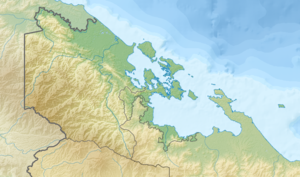Escudo de Veraguas
| Escudo de Veraguas | ||
|---|---|---|
| Aerial view of the island, north is below | ||
| Waters | Caribbean Sea | |
| Geographical location | 9 ° 6 '0 " N , 81 ° 33' 0" W | |
|
|
||
| length | 4 km | |
| width | 1.5 km | |
| surface | 4.3 km² | |
| Residents | 100 fishermen 23 inhabitants / km² |
|
| Map of the island | ||
Escudo de Veraguas is an island belonging to Panama in the Golfo de los Mosquitos , Caribbean Sea .
geography
The 4.3 km², almost uninhabited island, belongs to the Bocas del Toro province and is isolated 17 km from the Valiente peninsula of the autonomous, indigenous territory with provincial status Ngöbe-Buglé . It was separated from the mainland by the rise in sea level after the last cold period about 8,900 years ago, and was already separated from the mainland by 12 km of water around 1200 years after the separation. It has an approximately triangular shape with a length of about 4 km (~ east-west) and a width of 1.5 km (~ north-south), the western tip continues in a few tiny islets. Only 5% of the island surface is arable land, including some coconut - plantations . The remaining 95% is covered with evergreen forest, on the east and west coast in the form of swamps dominated by the red mangrove . The rest is covered by rainforest, mostly primary forest , but in the west some younger forest pieces of overgrown cultivated land. The landscape structure is determined by a series of parallel low (≥50 m) and flat domed hills that alternate with swampy lowlands.
Wildlife
The island is isolated enough from other islands and from the mainland that the populations of some of the mammal and bird species found on the island vary significantly from populations on neighboring land masses. The island is therefore home to some endemic species, including the pygmy sloth ( Bradypus pygmaeus ), an island dwarfed species of the three- toed sloth , and the species of bat Artibeus incomitatus, which belongs to the genus actual fruit vampires . A total of nine mammal species from the island are known, in addition to six bat species and the dwarf sloth the Central American opossum wool ( Caluromys derbianus ) and the armored rat ( Hoplomys gymnurus ). The island has a bird world that is poor in species for the region, but rich in individuals. Wetmore observed 17 species during a multi-day observation of the bird world in 1958, including three subspecies endemic to the island, Manacus vitellinus amitinus from the family of the Pipras , Thryothorus nigricapillus oducus of the genus Thryothorus the wren , and Thraupis virens caestia of the genus of the blue tangerine . In addition, a subspecies of the brown- tailed macaw , Amazilia tzacatl handleyi, lives on the island .
history
Francis Drake visited the island in January 1596 for two weeks, many of his crew members and he too fell ill with dysentery on the island ; Drake died of the disease five days after leaving the island at sea near Portobelo .
Individual evidence
- ^ A b Virginia Hayssen : Bradypus pygmaeus (Pilosa: Bradypodidae) , In Mammalian Species , American Society of Mammalogists, Issue 812, June 2008, pp. 1-4.
- ↑ a b c d E.KV Kalko and CO Handley: "Evolution, biogeography, and description of a new species of fruit-eating bat, genus Artibeus Leach (1821), from Panamá." In: Zeitschrift für Mammaliankunde 59 (1994) , Pp. 257-273.
- ↑ a b c Alexander Wetmore : The birds of Isla Escudo de Veraguas, Panamá. In: Smithsonian Miscellaneous Collections Vol. 139 (1961), No. 2. Smithsonian Institution , 1959, pp. 1-30 , accessed November 4, 2009 (Scanned August 9, 2008 by Smithsonian Institution Libraries ).


